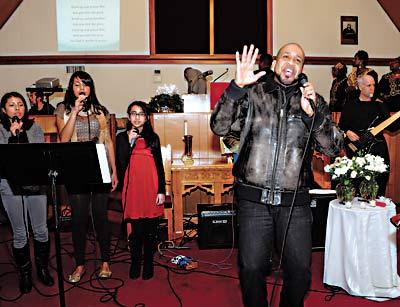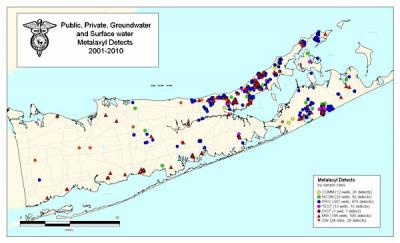Hope Amid the Heartbreak in Haiti
Hope Amid the Heartbreak in Haiti

On the second anniversary of one of the largest natural disasters of our time, Jonathan Glynn, an artist who lives in Sag Harbor, honored the occasion with a trip to Haiti to celebrate the groundbreaking of a new school and community center that his not-for-profit organization Wings Over Haiti is building. With attendees such as Danielle Campbell of News 12, the students of the already existing class put on a performance, and received their report cards.
The school, about eight miles north of Port-au-Prince in the town of Croix des Bouquets, was made possible by countless acts of charity and hard work by people on Long Island and in Haiti. The founders of Wings Over Haiti are committed to developing a community with independence through education.
“I am a white Jew from New Jersey, I don’t give handouts,” said Mr. Glynn, the founder and president, on Sunday. It’s more about giving a hand up, Ms. Campbell explained in her documented special on the trip, which aired on Channel 12 this week. Mr. Glynn said that giving hope to those who live in “the largest gravesite in human history,” is his priority. “ARF treats dogs better than these kids live,” he said.
“The only people getting paid are Haitians” — teachers and builders, for example. The money Wings Over Haiti has raised has also gone toward food for students, the land purchase, and construction materials for the new multi-use building that will house the school, a medical clinic, a center for adult education, and a community kitchen. Mr. Glynn hopes his integrated community model, including Wings Over Haiti’s lean budget, can be replicated from the ground up.
“We are feeding them twice a day,” said Mr. Glynn of the school’s 42 students. “Why educate the kids if we can’t keep them alive?” The larger community of 75 is fed meals that include cornmeal, beans, okra, bananas, and a small amount of chicken for necessary protein. “There are too many people to save,” said Mr. Glynn, seeming frustrated at the magnitude of need and at his own organization’s limitations.
That lesson was learned the hard way with the loss in June of a 4-year-old from complications of starvation. The child, Jean Eli, was the second in his family to die of malnutrition. It came to the attention of Carina Blon, an 18-year-old American volunteering to live on site in Haiti, that the child was taking the food he was fed at school to his family, instead of eating it. The loss was a terrible blow to the whole Wings Over Haiti community, and a pivotal point.
“Everything stops and we spend our own money when someone is about to die,” said Mr. Glynn. Most people in that area are lucky to eat one meal every three days, staying alive by drinking warm water mixed with salt, Mr. Glynn said. People also eat dried clay, formed into patties, in order to feel like they have eaten.
There is “zero medical care,” said Mr. Glynn, but many turn to voodoo practitioners to diagnose or treat what ails them. Mr. Glynn recalled that one woman in the community was told she was dying of a broken heart. When the doctor on call for Wings Over Haiti, Richard Ruppenstein, looked into the situation, it was found that the woman had pneumonia, and she was treated accordingly.
Dr. Ruppenstein, who has an office in Port Jefferson, has worked in Haiti since shortly after the earthquake. On his blog, reachhaiti.com, he said that he traveled the road from the east, north, and south of Port-au-Prince just after the earthquake without finding any relief or aid stations set up by any country. Not much has changed since then, he said.
Board certified in wound care, he enlisted the help several people, purchased two large suitcases full of medical supplies and medications, and walked around Haiti saving lives.
In addition to earthquake-related injuries and amputations, Dr. Ruppenstein wrote on his blog that infectious disease takes hold due to the lack of sanitation and food sources. Haiti has the highest crime rate in the hemisphere because, he said, despair, hunger, and hopelessness breeds criminality in the best human being.
Wings Over Haiti has purchased land up the road from the current school, which is on the property where Wings Over Haiti’s Haitian director, Shad St. Louis, grew up. Mr. St. Louis was working as a guidance counselor in Middletown, N.Y., at the time of the earthquake, and after reading about Mr. Glynn and becoming involved with Wings Over Haiti, he returned full time to his birthplace to take charge of the operation. While much remains to be done, Mr. St. Louis said it has been “a very successful year.”
Ms. Campbell, along with Melissa McMullan, the organization’s educational director, and Mr. Glynn, all agree that the Haitian crew building the new school are motivated, capable, and hard working. The architects, plumbers, and electricians are thrilled to have the chance to rebuild a better Haiti, they said. The day the land needed to be cleared, the mothers of the students arrived at the site with machetes and got the job done, Ms. McMullan said Monday. “Given the resources, these people can work magic.”
The design of the community building was a combined American-Haitian effort led by Al Tuff of Bridgehampton, recently named director of Wings of Haiti. Haitians improved upon some of the specifications, and the result is an earthquake-safe building expected to last 200 years. Wells and pumps on the property provide clean drinking water, and the 1,400-square-foot building will be powered with solar energy, making it possible to have an Internet connection and a freezer to store meat for the 42 children and their families.
Ms. McMullan became involved when her students at the J.F.K. Middle School in Port Jefferson Station insisted that she do so. After the earthquake, her students felt like they needed to do something, not just continue with the scheduled lesson plans. Their initial relief effort involved contacting businesses such as Proctor and Gamble to gather needed items, but they were turned down. Using the school district’s telephone database instead resulted in an outpouring of help from the Port Jefferson community. An example: half a ton of shoes were donated, then transported aboard a Hampton Jitney to Florida, to be shipped to Haiti.
After reading that Mr. Glynn was planning to fly to Haiti in his own plane to take medical teams and supplies, she approached him about taking some of the items her students had collected. She ended up with him in Haiti, creating a curriculum for children at the school his organization is building.
Her goal is to teach children critical thinking skills so that they can look around them and ask “What is wrong here, and what can I do about it?” she said. Helping families develop an economic base and providing them with life skills and career training are also essential parts of the program.
“They want to work, they want to learn, they want to grow their own food,” Ms. Campbell said. The school already has a community garden. Students are being taught in Creole, but there are plans to teach French and English, too.
Mr. Glynn sees the new building as a haven for students and their parents. “I will not be satisfied until the vision I have is complete,” he said.
With only $300 left in the Wings Over Haiti account, he recently took out a home equity loan to keep the project moving. “We need about $50,000 to get it done,” Mr. Glynn said on Sunday. “We’ve saved a lot of lives, but there is so much more to be done.” Those wishing to donate or find more information about his work can visit his Web site, wingsoverhaiti.org, where they can also purchase a children’s book about his experiences.
“Jonathan has taught all of us about the power one person has to really spark tremendous change,” Ms. McMullan said.






